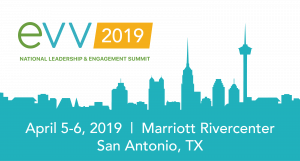 In an earlier post, I wrote about my attendance at the 2019 EVV Summit on April 5-6, 2019. Here’s part 2, with a look at Stakeholder Engagement and Self-Directed Care.
In an earlier post, I wrote about my attendance at the 2019 EVV Summit on April 5-6, 2019. Here’s part 2, with a look at Stakeholder Engagement and Self-Directed Care.
Stakeholder Engagement
One of the abiding themes of the conference was Stakeholder Engagement. The Act actually requires that Stakeholder Engagement be part of the State’s process of implementing EVV. Here is some text from the law: “The State shall…take into account a stakeholder process that includes input from beneficiaries, family caregivers, individuals who furnish personal care services or home health care services, and other stakeholders…”
This requirement for Stakeholder Engagement was a significant part of the conversations around what States had to do to be compliant. Methods discussed included direct mailing, traveling “townhall meeting” events, email campaigns, webinars and other on-line resources.
But who are all the stakeholders? According to one presenter, they include “Members” (Medicaid beneficiaries), Caregivers (family and non-family), authorized representatives, fiscal intermediaries, case manager/support brokers, advocacy groups, workforce councils, unions and community supports (Centers for Independent Living, public libraries, etc).
Interestingly, very few people attending this Summit were actually stakeholders, by this definition. About half the attendees were from State Agencies, the people tasked with figuring out how their States were going to deal with the mandate. Most of the others were vendors of one sort or another, interested in how they can help customers with (and profit from) the situation. I spoke with one representative from a large home care company in Texas; I believe he was the only representative from a home care agency present.
The big exception to the lack of actual stakeholders at this meeting was the presence of a contingent of self-directed care folks, which took the form of a protest by members of ADAPT (the people who brought us the Americans with Disabilities Act). That was a fascinating part of this conference and I’ll talk more about that later in this post.
Self-Directed Care
This is an area that I didn’t have much knowledge about prior to this Summit and it was very interesting to learn about it. “Self-directed care” (also known as consumer-directed care, participant-directed care, and other names) refers to care that is paid by Medicaid or other government programs but is provided by persons of the Client’s choice (very often family members).
Most (if not all) states have some form of self-directed care program. This is probably the hardest care to implement EVV for, since there is often no agency to manage things: the authority is with the recipient of care (Client). Effectively, the client is the employer and has control of scheduling and verification of services. Scheduling in particular is very flexible. In many cases, even the rate of pay is variable: they may have a budget so can pay more per hour but receive fewer hours of care, for example.
How do you get those people to do stuff like schedule and verify shifts? One answer is companies who deal with the payroll and compliance on behalf of these clients (referred to as FMS, or Financial Management Services companies). These companies will step in and do some of the administrative tasks for them.
The ADAPT Protest
The first session of the Summit was made very memorable by a contingent of self-directed care folks who staged a protest. As the session was about to start, a dozen or so people, several in wheelchairs, filed in and took their places at the front of the room. They acted out a skit designed to show some of the problems with using EVV for Self-directed Care. In the skit, a caregiver shows up at the client’s home to find them needing immediate assistance. But the caregiver can’t help them until they have clocked in. By the time the caregiver gets clocked in, the client is distraught and in need of a change of pants.
This protest was staged by members of ADAPT. After the skit, each of the members spoke passionately about their views on the new EVV mandate, which included the belief that EVV constitutes government surveillance and that it constitutes de facto institutionalization of clients (since they are required to be in their home at the start and end of the shift).
After they were done, they filed out peacefully. In the end, they were able to voice their opinions and feel heard by the organizers of the conference as well as by a number of government representatives (including Melissa Harris, Senior Policy Advisor of CMS).
One of the presenters made the observation that all of the state government people there were very calm about the protest, as it is something that happens regularly at public forums they are part of, whereas it was very new to the vendors in the room. Indeed, I can attest to the fact that there was a fair amount of nervousness in the room during the protest. I think that, if they had been shut down, it could easily have escalated into something much less respectful and productive.
